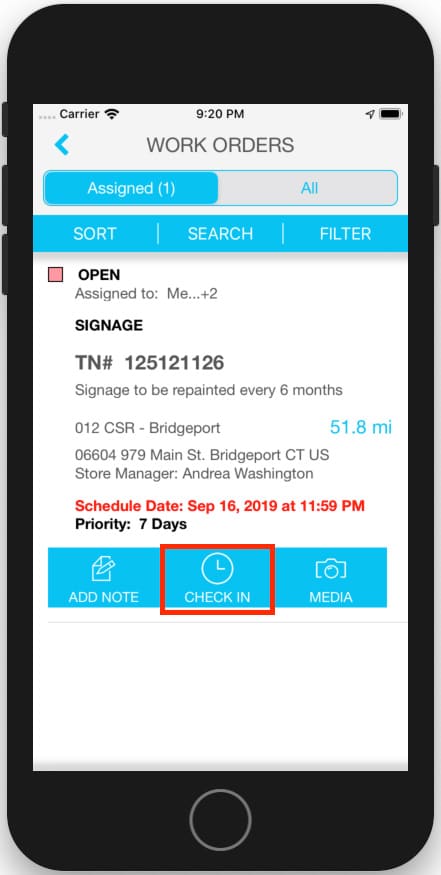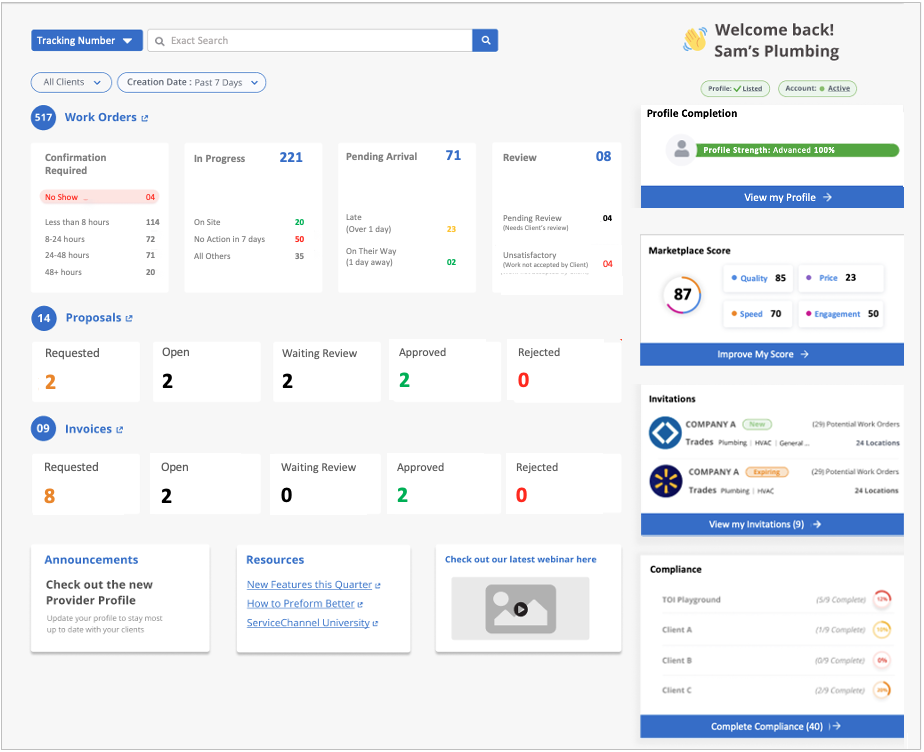Spotlight your great service in your own trades and service area.

New benchmarking feature in your Contractor Scorecard 2.0.
See how your performance compares
Today, in the new Contractor Scorecard 2.0, you and your customers can see at-a-glance whether your performance scores for Speed, Quality, Price and Engagement fall into the Top, Average, Below Average or Bottom quartile of all service providers on ServiceChannel.
Now with new functionality in the Contractor Scorecard, you and your customers can see how your performance excels compared not just to benchmarks set by all other service providers, but to benchmarks set by your true peers — the service providers in your specific trade and area of service, doing comparable repairs for customers in the same industry.
How it works
Make it a habit
FAQs
What benchmarking means for your business
Accurately highlight your great service for your customers
Of course, your performance scores, as well as the most appropriate benchmarks for comparison, will vary considerably based on any number of factors. With benchmarking, you and your customers can compare “apples to apples” so your great service really shines. For example:
- Say you’re an HVAC provider in Boise. The Price score that defines the most cost-effective HVAC providers in your area may be very different than the benchmark Price score for HVAC providers in the New York City metro area.
- If you specialize in servicing complex equipment — say large refrigeration systems in major supermarkets — you may well have Speed and Price scores that are inherently lower than a benchmark set by all providers. But when compared to other refrigeration providers servicing the same industry in your same geographic area, you’re right on top.
- If your biggest customer is in an industry such as health care, and their facility repair orders are almost always emergencies, your customer needs to see how your service compares to other providers specifically for P-1 work orders to assess your true value as a trusted provider.
- Seasonality can have an impact too. If your HVAC business services Minnesota and Wisconsin, your customers should see how you out-perform your peers in mid-winter. Or say your customers are mainly retailers, they may want to look at your great Speed score for work orders in peak holiday season from mid-October through December — or even your track record for responding promptly to P-1 emergencies over holiday weekends.
With insights like these from benchmarking, you and your customers have a more accurate, nuanced picture of your service level. With these shared insights, you can have more productive conversations that strengthen your partnership and their view of you as a valued service provider.
Get insights to fuel your growth
The calculations behind benchmarking also align more closely with how providers are ranked in ServiceChannel Provider Search, so you can easily see where you might focus to get discovered by more prospective new customers.
How it works
Get started by logging into ServiceChannel and selecting the scorecard tab on the top of any page.
- Use filters to select the specific parameters for both your scores and the most appropriate benchmarks for comparison.
- See this more nuanced comparison for each of your scores — Speed, Quality, Price and Engagement — as well as the individual performance indicators (KPIs) that make up each score.
- Get the new benchmarking view over all your customers or for a specific customer or group of customers.
- Drill down into related work orders to further isolate strengths and problem areas.
See where you stand overall. Starting from your Network Summary in the Contractor Scorecard 2.0, select the Benchmarking tab. Your default view will include all your repair work orders for all customers in the last 36 months, compared to benchmarks set by all providers on ServiceChannel.
Click the Speed, Quality, Engagement or Price tab to see how that score and the related KPIs fall into Top, Average, Below Average and Bottom quartiles. A color-coded bar in each line gives you an at-a-glance view.
See where you stand compared to your peers. To refine both your scores and the related benchmarks for each quartile, select one or more filters for trade, work order priority, state, county, major metropolitan market, and date range.
Select an industry to further refine the benchmarks.
See where you stand for specific customers. Use Subscriber, Brand and Location filters to see your scores for specific customers or customer locations against those same benchmarks.
See which work orders are connected to your scores. Click into any Speed or Quality score or KPI and see the work orders connected to your metrics even when filters are applied. Get to the source of any performance gaps by reviewing the specific work order detail for each score.
Make it a habit
Review benchmarks regularly. Make it a monthly practice to dive into your Scorecard and review benchmark comparisons for your trade.
Identify and spotlight what’s working well. Areas where you receive Top performance scores compared to your peers should be celebrated. Acknowledge these strengths with your team and your customers to build loyalty.
Spot opportunities to improve your scores. Quickly identify problem areas for any specific customer or type of work before they become a larger problem for your business.
More on scores
Provider performance scores highlight your great service: How performance scores can help you improve service and efficiency, get paid faster, and get discovered by new customers.
Contractor Scorecard 2.0. Use your scorecard to track your scores and KPIs in near real time for all of your customers, down to the work order level.
What your scores mean: See how your scores are calculated and what defines top performers based on current market conditions.
Top tips to boost your scores: Follow these best practices to provide great service and get discovered by new customers in Provider Search.
Frequently Asked Questions
How are my scores and the performance quartiles impacted by benchmarking?
When you launch your Contractor Scorecard 2.0, you immediately see how your scores fall into one of four “quartiles” compared to the average scores of all providers on ServiceChannel: Top, Average, Below Average, and Bottom.
When you apply filters on the Benchmarking tab, both your scores and the quartile thresholds are “dynamic” – they will change based on filters selected for trade, geographic location, industry, and work order priority. That way you and your customers have a comparison of your performance against all other providers matching those specific filters.
How can I use benchmarking to change the view of my scores?
With the new benchmarking feature, you can use the same filters to refine your metrics and see how they fit into the refined quartile definitions.
Can my customers see my benchmarked performance scores in the Contractor Scorecard?
Your current customers will be able to see your performance scores, but only your scores for their work orders. But with benchmarking, they can now see how your scores for their work orders compare to the benchmarks set by all providers matching the selected filters (the same benchmarks you see).
With the new scorecard, can any of my customers see my performance metrics for my other customers on the ServiceChannel platform?
Your customers are NOT able to see your performance scores for any of your other customers. However, with benchmarking, they can now easily see how your performance on their work orders compares to the aggregate performance benchmark set by all providers on ServiceChannel matching the filters they set.
Can prospective new customers see my benchmarked performance scores?
Only your current customers can access this information through the Contractor Scorecard. However, the new benchmarking calculations are much closer to the calculations used for ranking results in Provider Search. Prospective new customers who find you in search can only see your overall scores and the contributing KPIs, but you will be ranked in order of how well you match their specific search criteria — a similar function to benchmarking.
Can benchmarking help me improve my chances of being discovered by new customers?
All of the criteria used for benchmarking in the Contractor Scorecard 2.0 are included in the ranking algorithm for Provider Search, so benchmarking is a great tool to improve your ranking in Provider Search.
Does the benchmark include maintenance work orders?
No, both your scores and the comparison benchmarks for Speed, Quality, and Price are calculated based only on repair work orders and invoices. Your Engagement score is not based on work orders or invoices but on how effectively and consistently you engage with the ServiceChannel platform to instill customer confidence. Note you can still see your performance KPIs in the “Maintenance KPI Trends” tab of your Contractor Scorecard 2.0.
What does it mean if I see a blank in a column instead of a score for a customer?
A minimum of 10 work orders is required for a score to be calculated. If you see a blank, it simply means there were not enough work orders to calculate that score. Keep in mind as you apply filters, the pool of work orders available for calculating a score will be reduced. If you are seeing many blanks, try widening your view by removing a filter.



